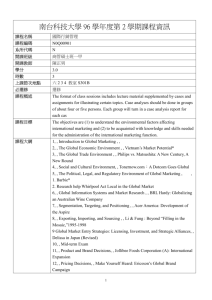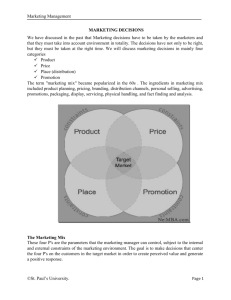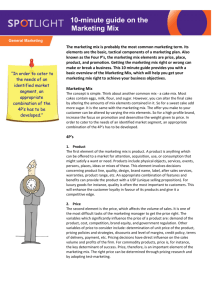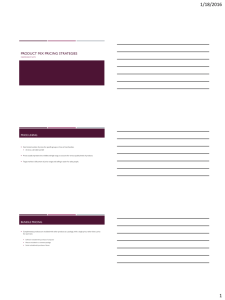practice-final-1-3
advertisement
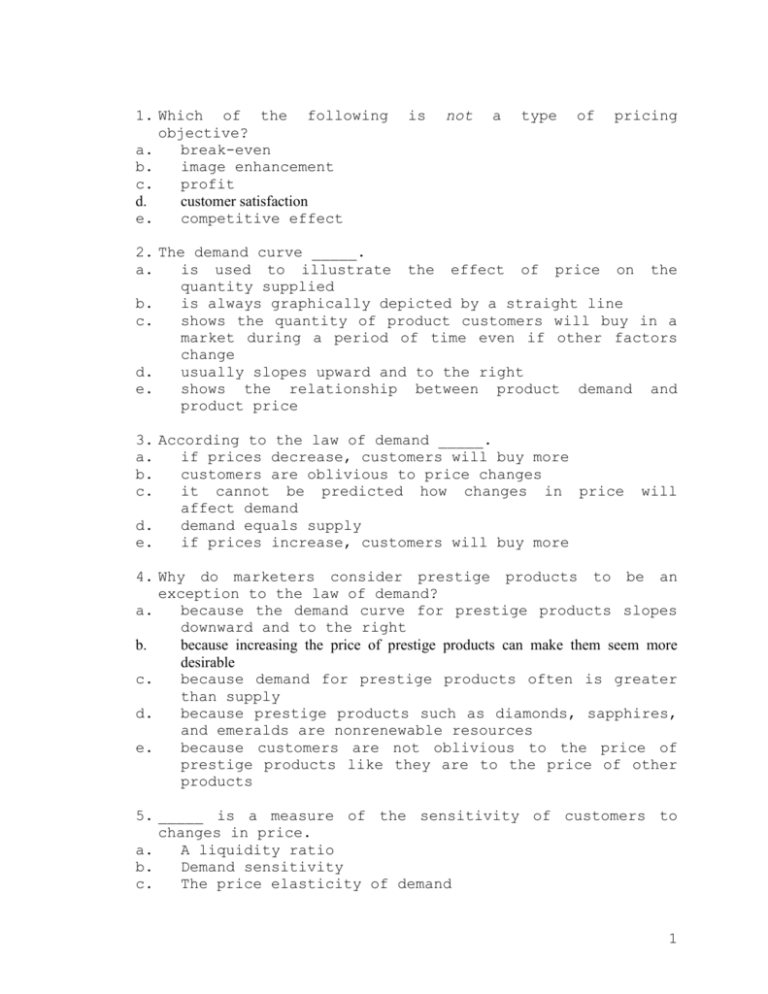
1. Which of the following objective? a. break-even b. image enhancement c. profit d. customer satisfaction e. competitive effect is not a type of pricing 2. The demand curve _____. a. is used to illustrate the effect of price on the quantity supplied b. is always graphically depicted by a straight line c. shows the quantity of product customers will buy in a market during a period of time even if other factors change d. usually slopes upward and to the right e. shows the relationship between product demand and product price 3. According to the law of demand _____. a. if prices decrease, customers will buy more b. customers are oblivious to price changes c. it cannot be predicted how changes in price affect demand d. demand equals supply e. if prices increase, customers will buy more will 4. Why do marketers consider prestige products to be an exception to the law of demand? a. because the demand curve for prestige products slopes downward and to the right b. because increasing the price of prestige products can make them seem more desirable c. because demand for prestige products often is greater than supply d. because prestige products such as diamonds, sapphires, and emeralds are nonrenewable resources e. because customers are not oblivious to the price of prestige products like they are to the price of other products 5. _____ is a measure of the sensitivity of customers to changes in price. a. A liquidity ratio b. Demand sensitivity c. The price elasticity of demand 1 d. e. Customer apathy A break-even analysis 6. When demand is inelastic _____. a. price and revenue change in the same direction b. revenues decrease when price increases c. revenue is unaffected by price changes d. quantity demanded increases when price increases e. the demand curve is more horizontal 7. The most common cost-based approach to pricing is _____. a. demand-based pricing b. psychological pricing c. skimming d. price discrimination e. cost-plus pricing 8. _____ means the selling price is based on an estimate of volume or quantity a firm can sell in different markets at different prices. a. Capacity management b. Price-floor planning c. Resale maintenance d. Penetration pricing e. Demand-based pricing 9. A firm is using _____ when it charges a high, premium price for a new product with the intention of reducing the price in the future. a. a skimming price b. trial pricing c. price-quality inference pricing d. penetration pricing e. prestige pricing 10. A firm is using a _____ strategy when it introduces a product at a very low price to encourage rapid product adoption. a. skimming pricing b. comparative pricing c. price-quality inference pricing d. penetration pricing e. corrective pricing 2 11. _____ refers to the sale of two or more goods and services as a single package for one price. a. Price skimming b. Comparative pricing c. Captive pricing d. Price bundling e. Penetration pricing 12. All of the following apply to advertising except _____. a. paid for by an identified sponsor b. face-to-face communication c. uses mass media to persuade or inform an audience d. nonpersonal communication e. informative 13. _____ is/are advertisements the media charge. a. Product advertising b. Advocacy advertising c. Public service advertisements (PSAs) d. Limited-line strategy e. Position strategy runs free of 14. Which of the following is an example of a sales promotion? a. a coupon for $5 off a visit to an amusement park b. a reduced price on a movie ticket because you are willing to attend a matinee c. a news release encouraging voters to support a new bond issue for a local elementary school d. a listing of all the television programs to be shown by Charter Cable in the Rome area the week of March 16 e. a plan to increase the sale of ice cream by adding two new flavors 15. The free can of shave gel Matt received purchased a razor is an example of _____. a. internal marketing b. green marketing c. a sales promotion d. cause marketing e. market diversification when he 3 16. _____ attempts to influence the attitudes and perceptions of consumers, stockholders, and others toward companies, brands, politicians, celebrities, not-forprofits organizations, and so on. a. Sales promotion b. Public relations c. Cause marketing d. Personal selling e. Image management 17. _____ occurs when a company representative contacts a prospect directly regarding a good or service. a. Cross-promotion b. Sales management c. Mass selling d. Personal selling e. Prospecting 18. Which of the following statements about direct marketing is true? a. Mail order is the oldest form of direct marketing. b. Mail order is the most popular type of direct marketing. c. Permission marketing is commonplace in the direct marketing industry. d. Telemarketing is a form of direct marketing. e. All of the above statements about direct marketing are true. 19. Sarah’s favorite catalog that comes to her apartment is an example of_____ . a. place-based communication b. direct marketing c. out-of-home communication d. direct selling e. promotional selling 20. Which of the following statements about the steps in the target marketing process is true? a. The first step in the target marketing process is to set marketing objectives. b. There are four steps in the target marketing process. c. The second step in the target marketing process is the identification of all segmentation variables. d. The final step in the target marketing process is positioning. e. The target marketing process is not related to positioning. 4 21. Age, ethnicity, geographical region, and lifestyle are all examples of _____. a. segmentation variables b. positioning strategies c. synergistic samples d. homogenous populations e. sampling heuristics 22. Demographics _____. a. segments people on the basis of what they do with a product b. segments people on the basis of when they use a product c. uses qualitative data to explain why seemingly homogeneous consumers are not d. segments people on the basis of shared attitudes, opinions, and interests e. are measurable characteristics such as age and gender 23. The 80/20 rule is most directly related to _____ segmentation. a. demographic b. behavioral c. geodemographic d. socioeconomic e. psychographic 24. A viable target market should _____. a. have homogeneous wants and needs that differ from those of other segments b. be measurable c. be large enough to be profitable now and in the future d. be reachable through marketing communications e. all of the above 25. _____ means developing a marketing strategy aimed at influencing how a particular market segment perceives a good or service in comparison to the competition. a. Concentrated targeting b. Positioning c. Benefit segmentation d. Mass customization e. Customerization 26. CRM stands for _____. a. consumer relationship marketing b. consumer relationship management c. customer relationship management d. customer relationship marketing e. customer relations marketing 5 27. Recognizing that some people eat cereal because of its nutritional value, that some people eat cereal because it is easy to prepare, and some eat cereal because it tastes good is part of the _____ process. a. acculturation b. segmentation c. customerization d. market aggregation e. positioning 28. A company has only one product line—all the company manufactures is supercomputers. This one product line is also the company’s _____. a. target market b. co-brand addition c. promotional mix d. product mix e. marketing mix 29. Unilever, the manufacturer of many recognizable brands of consumer products, has announced that it plans to cut its number of product lines from a high of 1,600 different products to 400 products so that it can concentrate on increasing its efficiency. This is an example of a(n) _____. a. downward line stretch b. value stretch c. upward line stretch d. product line contraction e. filling-out strategy 30. Innovators are not _____. a. typically better educated than other segments in the population b. younger than others in the population c. people who like to boast about being the first to try a new product d. typically described as worldly e. the last person to try a new product 31. _____ are the last in the population to adopt a new product. a. Laggards b. Late majority adopters c. Slackers d. Shirkers e. Dawdlers 6 32. Which of the following statements about customer relationship management (CRM) programs is true? a. The success of a CRM program relies on its use of mass communication channels. b. CRM programs include any communication channel that allows the customer to communicate directly with a company. c. Internet technology is viewed as a barrier to the implementation of CRM programs. d. To succeed, all companies should engage in CRM every time they interact with a customer. e. Only consumer marketers can benefit from the use of CRM programs. 33. The first step in the adoption process is _____. a. product evaluation b. awareness c. problem recognition d. need evaluation e. interest 34. A good brand name should do all of the following except fit _____. a. legal requirements b. the customer’s culture c. the product’s benefits d. the competition e. the target market 35. A _____ is the legal term for a brand name, brand mark, or trade character. a. trademark b. copyright c. corporate mark d. patent e. logotype 36. Which of the following is the best example of a durable good? a. bag of cat food b. computer printer c. bottle of nail polish d. package of light bulbs e. detergent 37. Generic brands _____. a. are more popular today than ever before b. were first developed during the last period of economic prosperity in the United States c. were designed to appeal to the price-conscious consumer d. attract approximately 25 percent of all dollars spent in the U.S. supermarkets are manufacturer’s brands 7 38. Product packaging _____. a. protects the product b. makes the product easy for consumers to store c. communicates brand personality d. can create a competitive advantage e. all of the above 39. When a consumer buys a ScumBuster®, the core product is the ability to get surfaces clean. The _____ is the physical, cordless scrubber. a. function b. actual product c. augmented product d. benefit e. attribute-based shopping good 40. The last stage in the new-product development process is _____. a. commercialization b. business analysis c. idea generation d. concept testing e. product concept development 41. Diffusion refers to _____. a. how promotion is used to support products throughout their product life cycle b. the second stage of the market segmentation process c. the methodology used for evaluating new product ideas d. how the use of a product spreads throughout a population e. the selection of opinion leaders to encourage product acceptance 42. Which of the following is not identified as one of the five characteristics of innovations that affect the rate of adoption? a. relative advantage b. tangibility c. observability d. trialability e. compatibility 43. _____ is the degree to which a consumer perceives that a new product provides superior benefits. a. Compatibility b. Complexity c. Relative advantage d. Comparability e. Tangibility 8 44. A firm’s _____ is the entire range of products the company offers for sale. a. branding strategy b. promotional mix c. positioning strategy d. product mix e. product line 45. When a traditional banking company launched a freestanding all-Internet bank, many regular customers of the bank became customers of the Internet bank. The bank experienced _____. a. disintermediation b. cannibalization c. cross-docking d. a piggyback exchange e. pyramiding 46. Mattel teamed with Coca-Cola to market Soda Fountain Sweetheart Barbie. This is an example of _____. a. co-branding b. contract manufacturing c. generic branding d. family branding e. aggregated branding 47. Which of the following statements about brand equity is true? a. Brand equity means a brand has customer loyalty. b. Brand equity refers to the brand’s value to an organization. c. Brand equity can provide a competitive advantage. d. Brand equity gives a firm the power to capture and hold onto a larger share of the market and to sell at prices with higher profit margins. e. All of the above statements about brand equity are true. 48. The final stage in the product life cycle is _____. a. maturity b. phasing out c. decline d. harvesting e. divestment 50. Whenever a product line or a product family is extended, there is a risk of _____, which occurs when sales of an existing brand decline as the firm’s current customers switch to the new product. a. disintermediation b. cannibalization c. cross-docking d. a piggyback exchange 9 e. pyramiding 49. All of the following apply to advertising except _____. a. paid for by an identified sponsor b. face-to-face communication c. uses mass media to persuade or inform an audience d. nonpersonal communication e. informative 50. _____ is/are advertisements the media charge. a. Product advertising b. Advocacy advertising c. Public service advertisements (PSAs) d. Limited-line strategy e. Position strategy runs free of 51. Which of the following is an example of a sales promotion? a. a coupon for $5 off a visit to an amusement park b. a reduced price on a movie ticket because you are willing to attend a matinee c. a news release encouraging voters to support a new bond issue for a local elementary school d. a listing of all the television programs to be shown by Charter Cable in the Rome area the week of March 16 e. a plan to increase the sale of ice cream by adding two new flavors 52. The free can of shave gel Matt received purchased a razor is an example of _____. a. internal marketing b. green marketing c. a sales promotion d. cause marketing e. market diversification when he 53. _____ attempts to influence the attitudes and perceptions of consumers, stockholders, and others toward companies, brands, politicians, celebrities, not-forprofits organizations, and so on. a. Sales promotion b. Public relations c. Cause marketing 10 d. e. Personal selling Image management 54. _____ occurs when a company representative contacts a prospect directly regarding a good or service. a. Cross-promotion b. Sales management c. Mass selling d. Personal selling e. Prospecting 55. a. b. c. d. e. Telemarketing _____. is a form of direct selling is a form of personal selling is a form of sales support A and B A, B, and C 56. Which of the following statements about direct marketing is true? a. Mail order is the oldest form of direct marketing. b. Mail order is the most popular type of direct marketing. c. Permission marketing is commonplace in the direct marketing industry. d. Telemarketing is a form of direct marketing. e. All of the above statements about direct marketing are true. 57. Sarah’s favorite catalog that comes to her apartment is an example of_____ . a. place-based communication b. direct marketing c. out-of-home communication d. direct selling e. promotional selling 58. A brochure sent through the mail offering a specific product or service at one point in time is _____. a. spim b. direct mail c. catalogs d. telemarketing project e. spam 11 59. _____ occurs when a company representative contacts a prospect directly regarding a good or service. a. Cross-promotion b. Sales management c. Mass selling d. Personal selling e. Prospecting 60. Telemarketing _____. a. is a form of direct selling a. is a form of personal selling b. is a form of sales support c. A and B d. A, B, and C 12
